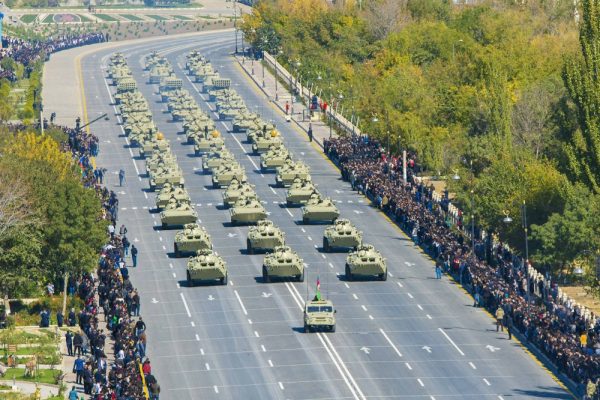
Nakhchivan Again Site of Broader and More Dangerous Geopolitical Competition
Publication: Eurasia Daily Monitor Volume: 15 Issue: 90
By:

Ankara’s announcement last week (June 6) that it will begin building a railroad up to the Turkish border with Nakhchivan later this year, combined with news of Baku’s redeployment of military forces along the Armenian border of that non-contiguous portion of Azerbaijan (see EDM, June 4), are sparking fears in Yerevan and Moscow. Some Armenian and Russian officials and experts worry these developments suggest the war between Azerbaijan and Armenia may soon resume from a new direction. Others fret that Ankara may use the territory of this exclave to link up with Iran’s rail system, or even that this region’s two Turkic countries could challenge Yerevan’s control of Zengezur—the area that separates Nakhchivan from Azerbaijan proper and the only land bridge Armenia has to Iran and the outside world.
Two important exclaves exist in the South Caucasus, both of which were created by Soviet leader Joseph Stalin but which have quite different statuses today. Because of the simmering three-decade war between Armenia and Azerbaijan, most people are familiar with Karabakh, an Armenian-majority region but one that Stalin made an autonomous republic within and under the control of Azerbaijan. Far fewer are aware of the second, Nakhchivan, an Azerbaijani-majority region which is part of Azerbaijan but is separated from the rest of that republic by Zengezur, which is part of Armenia and today is populated by an Armenian majority.
Stalin imposed this asymmetrical situation for two reasons. On the one hand, he wanted to ensure that tensions between Armenia and Azerbaijan would remain high, allowing Moscow to use its time-tested approach of divide and rule. But on the other, and perhaps even more important with regard to the borders of Nakhchivan, the Soviet dictator wanted to deprive Turkey of a direct land bridge to Azerbaijan and Turkic Central Asia while giving Armenia an external Soviet border to Iran. As Stalin drew the borders, Turkey gained a 13-kilometer connection with Nakhchivan; however, Turkey could reach Azerbaijan only by passing through Armenian or Iranian territory. That geographical arrangement has remained in place since the Soviet-Turkish Treaty of Kars of 1921 (which also remains in force) and gives the two powers special rights with respect to the borders of Nakhchivan.
This situation has always been a sore spot for Ankara, Baku and Yerevan. And recent moves have seriously exacerbated tensions about it. Last week, the Turkish government announced that, over the next several months, it would begin building a 224-kilometer rail line up to the border of Nakhchivan that would allow it to reach Iran and, via Iran, Azerbaijan. Turkish officials pointedly noted that both Iran and Azerbaijan support the project, but they made no mention of Armenia or its concerns (Haber Turk, June 6).
And those are not trivial. Armenia has long worried about the projection of Turkish power into the region by the establishment of a rail connection; it fears that if Turkey moved that far, it might help Azerbaijan to seize Zengezur, giving it a direct and unimpeded route to Baku and Central Asia beyond. Both for geopolitical reasons and because Russia is the most important guarantor of Armenia’s security—there is a significant Russian military presence there—many in Moscow share those concerns and will work to counter them (Vpoanalytics.com, June 5; Fondsk.ru, June 11).
These Armenian and Russian concerns, in turn, were heightened by Azerbaijan’s decision to organize major military maneuvers in Nakhchivan earlier this spring (see EDM, June 4). At that time, Baku’s forces moved closer to the Armenian border, something Yerevan saw as a threat. Armenian fears were exacerbated by the fact that, in 2014, Azerbaijani President Ilham Aliyev told soldiers stationed there that, within three years, there would be a direct rail link between Turkey and his country, something their presence would help guarantee (Kavkazoved.info, June 15, 2014).
David Petrosyan, a Yerevan-based journalist, suggests one of the reasons these current developments are sparking tensions: With the exception of small clashes in 2014, the Armenian-Nakhchivan border has been “the most peaceful segment” of the de facto border between Armenian-controlled territory and Azerbaijan. He implies that for that status quo to collapse now, in the wake of political turbulence in Armenia, some in Baku and possibly in Ankara are potentially prepared to exploit the situation to threaten Armenia in small ways or large (Vpoanalytics.com, June 5).
But there are even greater issues to consider. Turkey and Russia are involved in a complicated diplomatic and military-political dance in Syria, and Moscow is concerned about any rapprochement between Ankara and Tehran, something that could severely limit Russia’s ability to maintain its positions in Syria and project power into the Middle East more generally. And more generally at least some in the Russian capital are worried that the news about the Turkish railroad and the Azerbaijani maneuvers in Nakhchivan are the kind of shifts in “tactical positions” that could easily become more permanent “strategic” problems (Regnum, June 9).
None of this means that a military conflict is imminent. But it is likely that Moscow will use the Turkish and Azerbaijani moves to push Armenia to accept a still larger Russian military presence. It is also likely that Ankara and Baku will move cautiously in response. And it is almost certain that Iran will enjoy being in a position where Russia will support it being an east-west transit link for Turkey and Azerbaijan lest the two Turkic countries make any moves against Zengezur.



